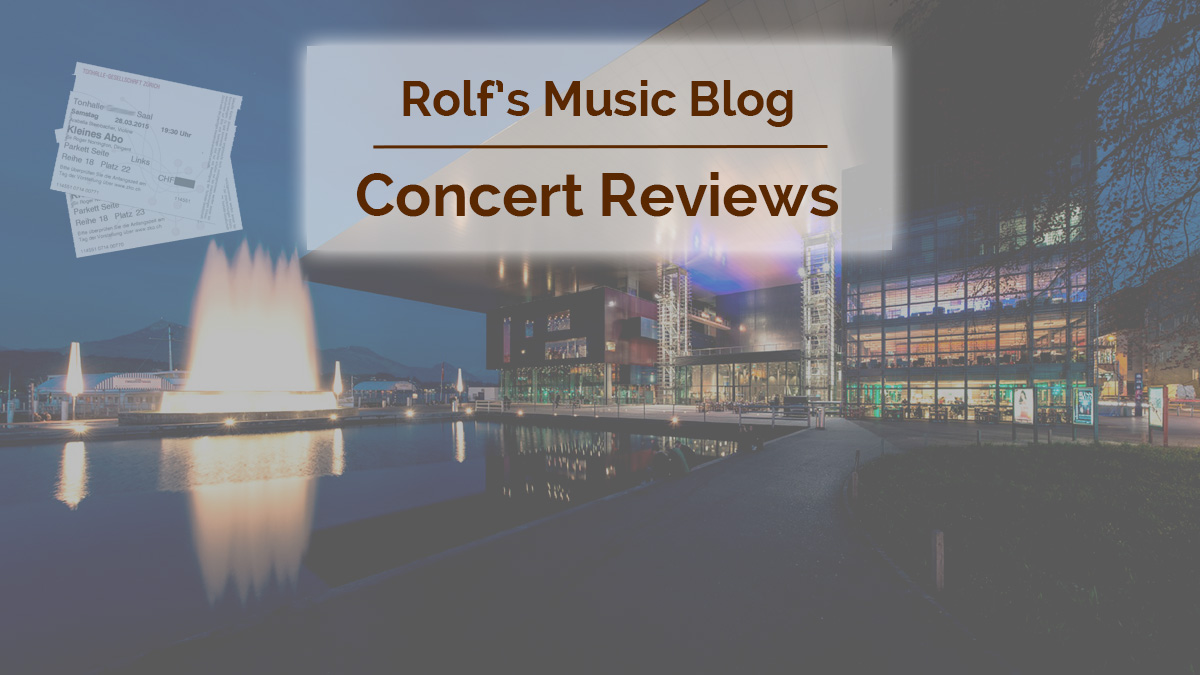Paul McCreesh / Gabrieli Consort & Players
Handel: Messiah
KKL Lucerne, 2015-12-19

2015-12-22 — Original posting
2016-08-23 — Brushed up for better readability
Table of Contents
Introduction
This was the last concert in 2015 that SwissClassics organized as part of the series “Lucerne Chamber Circle” in the KKL Lucerne. The Lucerne Chamber Circle features chamber music and music with smaller or chamber orchestras, typically historically informed performances. These Concerts are not part of the Lucerne Festival. The program for the evening consisted of one single, large composition: the popular Oratorio “Messiah” (HWV 56) by George Frideric Handel (1685 – 1759).
The Oratorio
Handel composed the oratorio in 1741. The first performance was in Dublin on 1742-04-13; the London premiere was in the following year. As most of Handel’s oratorios, this is an evening-filling composition for orchestra, choir, and four soloists, consisting of 54 “numbers” (recitatives, arias, duets, choruses) in three parts. The program notes described the oratorio as follows:
- Part I
- The prophecy of Salvation
- The Prophecy of the coming Messiah and the question, despite, of what this may portend for the world
- The prophecy of the Virgin Birth
- The appearance of the Angels to the Shepherds
- Christ’s redemptive miracles on earth
- Part II
- The redemptive sacrifice, the scourging and the agony on the cross
- His sacrificial death, His passage through Hell and Resurrection
- God discloses His identity in Heaven
- Whitsun, the gift of tongues, the beginning of evangelism
- The world and its rulers reject the Gospel
- God’s triumph
- Part III
- The promise of bodily resurrection and redemption from Adam’s fall
- The Day of Judgement and general Resurrection
- The victory over death and sin
- The glorification of the Messianic victim
This looks mostly like “theoretical / theological contemplations”, based on the Bible: it’s not so much the text content, for which people know this oratorio, but for Handel’s music.
The Reception of the Oratorio Over Time
Still, initially, the oratorio wasn’t that much of a success, and even the saying that King George II stood up for the “Hallelujah” (forcing everybody else to stand up) may be legend only. There is no real evidence that the king attended any performance of the “Messiah”. The success of the oratorio only really started in the second half of the 18th century. It culminated in performances with huge orchestras and masses of choristers. Only in the late 20th century, people started returning to settings that are more consistent with what Handel may have used and may have composed the oratorio for.
The Venue
This concert was given in the “white” hall of the KKL (Congress and Culture Center Lucerne). Unfortunately & strangely, the event was far from sold out. Are people too busy on a Saturday, less than a week before Christmas?
I had excellent seats near the center of the hall, so the comments below should not be distorted by unbalanced hearing, such as from a side-balcony seat. However, really, in the KKL there are not supposed to be bad seats…
The Performance
I’ll refrain from giving more comments on the composition, as the oratorio is very well-known. Also, discussing the concert performance by following the score would be really boring, given the large count of 54 numbers. I’ll rather discuss the concert by artists / performers:
Choir
As most or all of Handel’s oratorios, “Messiah” as a composition revolves around / focuses on the choir. In this performance, this was the Gabrieli Consort. This is a choir which Paul McCreesh founded in 1982, together with the Gabrieli Players. These formations have remained under his direction since their inception. The choir is a small ensemble of 23 professional singers (7 sopranos, 3 + 3 altos and countertenors, 5 tenors, 5 basses). What the choir offers in terms of flexibility, virtuosity even in the fastest passages, precision in coloraturas, and of course clarity of diction, is by far superior to anything a lay choir could ever dream of achieving.
Vocal Qualities
Despite the small number of singers, the choir features exceptional homogeneity within each of the voices, even in the case of the 3 altos and 3 countertenors. Also the balance between the voices is outstanding. The ensemble achieves an amazing volume. At the same time, the intense, controlled, and always well-projecting pp and ppp (e.g., in “Behold, I tell you a mystery”) is exceptional. Similarly, the choir shines with very differentiated dynamics and careful phrasing.
Flexibility, Precision
On top of that, the choir excels with light articulation and relaxed, almost effortless, yet always reliable and precise coloraturas. These remain subtle even at the fastest of McCreesh’s tempos (e.g., in “For onto us a Child is born”, or even more with “All we like sheep”). More highlights: the dramatic “Surely he hath borne our griefs”, the subsequent virtuosic fugue “And with his stripes”, and “Lift up your heads” with almost instrumental flexibility and dynamics.
Orchestra
The foundation, the “glue” of the performance (and the oratorio) is the orchestra, the Gabrieli Players: a compact instrumental ensemble of ideal size (6 + 6 violins, 4 violas, 4 cellos, 2 double basses, 2 oboes, bassoon, 2 natural trumpets, harpsichord, chest organ, drums). The ensemble uses historic instruments (or replicas) throughout (baroque bows). The players obviously have a very profound experience in historically informed, baroque playing. The soft, almost velvety sound of gut strings is fascinating. I particularly liked how the baroque oboes with their mellow timbre never dominated, but ideally mixed with the sound of the strings.
And of course, also the orchestra played with light articulation. Maybe with a few exceptions, when McCreesh pushed the tempo to or slightly above the limits. The intonation in both the orchestra and the choir was impeccable, with the one, minor exception of the first bars that the trumpets played: the trombe only enter the stage during the second part. But this is just a small issue that the musicians corrected at the first opportunity.
Conductor
The performance was directed by the founder of Gabrieli Consort & Players, Paul McCreesh (*1960), the founder of Gabrieli Consort & Players, directed the performance. He conducted the entire oratorio (over 2 hours of music in 54 “numbers”, after all) by heart. The oratorio was performed unabridged.
Paul McCreesh likes a fluent, even fast tempo, particularly for the virtuosic pieces: he pushes choir and orchestra to the limits; in the more quiet sections he selected a natural tempo, without excess sweetness. For example, he avoided over-indulging in the well-known “Pifa“, causing that short piece to be over before one really recognized it being played.
In some of those popular highlights of the oratorio, McCreesh avoids unnecessary pathos. One striking example to me: in German-language performances, the choir “Blessing and honor, glory and pow’r be unto Him, be unto Him” (“Alle Gewalt, und Ehr, und Macht, und Lob, und Preis gebühret ihm“) is sometimes a heavily stomping piece (already from the somewhat clumsy translation). Here, it was fluent, as fast as the language / diction permitted, which totally altered the character of the chorus.
In the same piece, the more solemn segments (“Worthy is the Lamb”) avoided excess weight and heaviness, yet remained intense, convincing. Overall, I found McCreesh’s concept to be really compelling, throughout. For additional remarks see under “Conclusion” below.
Soloists (in the Order of Their Appearance)
Stuart Jackson, Tenor
Stuart Jackson (*ca. 1986) sung the tenor part. He is a tall, impressive singer with a mellow, almost velvety, projecting voice with a pleasant timbre and excellent internal balance. At this point, Jackson’s voice is not very big, certainly not dominant. But the singer has good diction. Stuart Jackson supported his singing with vivid facial expression and arm gestures. But he was not exceedingly theatrical.
To me, the least convincing aspect about his singing were the coloraturas, the few free cadenzas. But these are abilities that he sure will acquire over the coming years, as hopefully also the voice will gain some extra volume. A few details: in the accompagnato “Thy rebuke hath broken his heart”, the p / pp lacked some projection (same with the aria “Thou shalt break them”), and sometimes the diction (to me) sounded too open.
Neal Davies, Bass
Next to Stuart Jackson was the bass Neal Davies: his singing was expressive, dramatic. For most of the performance, his voice did not sound really huge / big. Or did he deceive my perception through his small stature, particularly next to the tall tenor?
I sometimes (in some pieces) felt that he tried compensating missing volume through exceedingly open articulation. This affected the clarity of his diction. It also unnecessarily brightened his timbre, moving the focus to the harmonics. This made it harder to recognize the pitch of his voice.
In “Why do the nations“, his coloraturas sounded a bit pushed, exaggerated, too dramatic (he is an opera singer!). On the other hand, the aria “The trumpet shall sound” was impressive, maybe lacking some volume in the lowest register. Handel has set this so ideally for the bass voice that it is now a “pièce de résistance” in the education of probably every bass singer. In other words: it is not a tough challenge.
Iestyn Davies, Countertenor
For me, the second, real highlight of this “Messiah” performance (after the choir) clearly was the countertenor Iestyn Davies (*1979). That’s a singer who has already performed and recorded this part with other conductors (see the recordings below). He had the biggest part of all soloists. On short notice, two numbers originally written for soprano were added to his part in that performance.
If there is anything missing in volume in his voice (compared to the “big” female alto voices of our days), Iestyn Davies more than compensated that through evenness in timbre and volume in his voice, his superior ability in phrasing, in shaping the music, the natural and easy, natural flow of his coloraturas and extra ornamentation, his messa di voce, and, above all, the intensity and depth of expression in his singing.
Already his first two parts really touched me: “Thus said” and “But who may abide“. But to me, his interpretation of the aria “He was despised” (the second piece in part II) turned into the real highlight and pivotal point in the entire oratorio. A very touching performance that sent shivers down my spine!
In the second part, his aria “Thou art gone up on high” is vocally very demanding. This again was excellent in intonation and voice control. The extra ornamentation in da capo parts in his arias were always fitting ideally. They never felt put-on. To me, they were natural (almost like improvised) rather than fabricated. In the duet “O death, where is thy sting“, the vocal parts were dynamically fairly well in balance. Still, Iestyn Davies’ voice appeared to dominate over that of the tenor.
Sarah Tynan, Soprano
The least convincing part among the soloists was that of the soprano Sarah Tynan. To me, her vibrato was too strong, the voice too dramatic and also too uneven over her vocal range. Her vibrato sometimes conflicted with her voice control in coloraturas. McCreesh’s fast tempo may have contributed to this.
The most disappointing part to me was her aria “I know that my redeemer liveth“, one of Handel’s most beautiful inventions. Here, her voice lacked volume in the lower register, and (worse than that) the singer fell into the trap of unnecessarily enforcing the high peak notes. Instead, she should have been holding them back, as they naturally outshine the rest of the melody anyway. That energy would be much better spent on making her voice more even over the entire range. Her singing was dramatic, maybe artful, yet without the intensity of expression that is so central in this aria.
Conclusion
The performance of “Messiah” ended with an “Amen” that gradually built up from a soft, gentle beginning into an impressive, broad, but not overpowered climax. Once more, McCreesh avoided excess pathos. Maybe there was a tad too much legato in the strings. The applause was strong, cordial, but not overly enthusiastic. With the exception of the choir, none of the artists received a special applause. This was probably to be expected from a predominantly older subscription audience.
In the “Hallelujah” (at the end of part II), people in the audience showed no signs of wanting to stand up. OK, that tradition is not “genuine” here (lacking royalties!), but I still have seen it happen in local performances. In such cases, this may be originating from insider enthusiasts, such as relatives of singers in the choir, etc.
Personally, I really enjoyed this concert evening. The “Messiah” is an oratorio that never fails to move & touch. I experienced a performance that may not have been perfect throughout, but nevertheless featured some very impressive, top-class highlights.
Addendum 1
For the same concert, I have also written a (much shorter) review in German for Bachtrack.com. This posting is not a translation of that German review, the rights of which remain with Bachtrack. I create the German review using a subset of the notes taken during this concert. I wanted to enable my non-German speaking readers to read about my concert experience as well. Therefore, I have taken my original notes as a loose basis for this separate posting. I’m including additional material that is not present in the Bachtrack review.
Addendum 2
For those who are interested in studying this music using a score, here is a link where you can purchase the Eulenburg pocket score.
Recordings on CD
Paul McCreesh sold and signed his CD recording of the “Messiah”, also with the Gabrieli Consort & Players, after the concert, see below. Note that this is an older recording (1996), now dating back almost 20 years. Therefore, it does not (cannot) feature Iestyn Davies. The alto here is Bernarda Fink. With the exception of the (then very young) bass Neal Davies, none of the singers match those in this concert. Note that there are two soprano voices in this CD performance. I haven’t listened to that recording yet. I’m providing this information merely for reference.
Are you looking for a recording of the “Messiah” featuring Iestyn Davies? This artist is participating in the 2008 recording of the Messiah with the choir Polyphony and the Britten Sinfonia under the direction of Stephen Layton. Note: also the information about this recording from my CD collection is just for reference. I haven’t listened to that performance yet.
Paul McCreesh, Gabrieli Consort & Players (1996)
Handel: Messiah
Paul McCreesh, Gabrieli Consort & Players
Dorothea Röschmann, Susan Gritton, Bernarda Fink, Charles Daniels, Neal Davies
DG / Archiv Produktion Duo 477 9574 (2 CDs, stereo); ℗ 1997 / © 2011
Booklet: 18 pp. en/de/fr

Stephen Layton, Polyphony, Britten Sinfonia (2008)
Handel: Messiah
Stephen Layton, Polyphony, Britten Sinfonia
Julia Doyle, Iestyn Davies, Allan Clayton, Andrew Foster-Williams
hyperion CDA67800 (2 CDs, stereo); ℗ / © 2009
Booklet: 28 pp. en/de/fr














